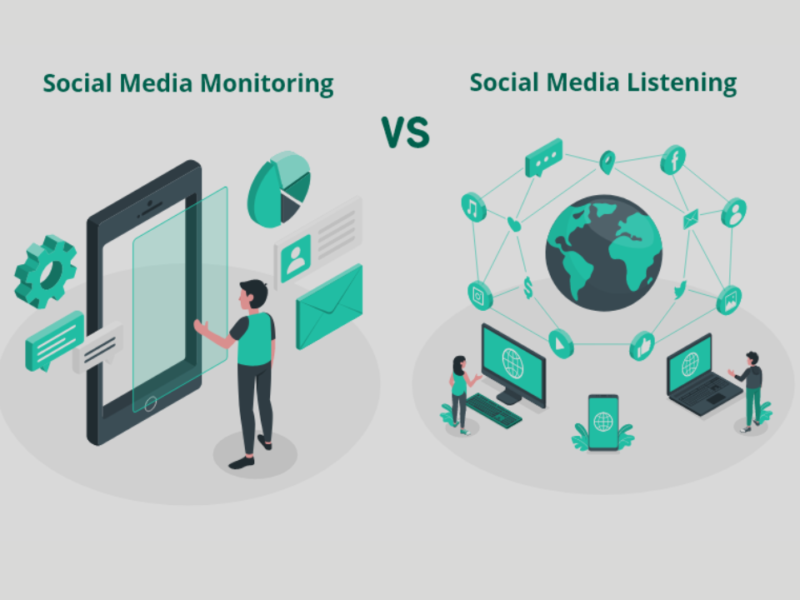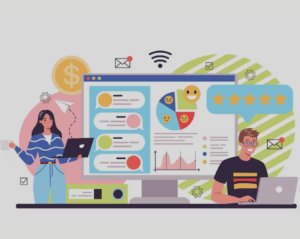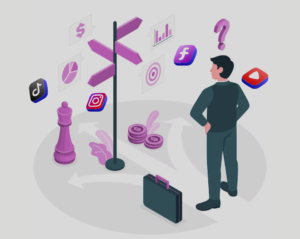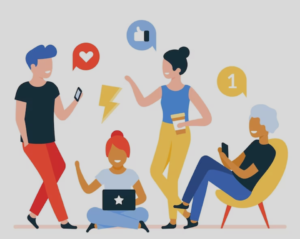Table of Contents:
- Introduction
- What is Social Media Monitoring?
- Why should brands monitor social media?
- What is Social Media Listening?
- Why do brands listen to social media?
- Social Media Monitoring Vs Social Media Listening
- Benefits of Social Media Listening
- Benefits of Social Media Monitoring
- A unified Social Monitoring and Listening Strategy
- Invest in Social Monitoring and Listening Solutions
- Best Practices: Social Media Monitoring and Listening
- Social Media Monitoring and Listening: Which One is Better?
- Conclusion
- About Konnect Insights
Introduction
Social monitoring and social listening might seem similar, but they have different meanings. For people working in digital marketing, knowing the difference is essential.
Digital marketing involves many different aspects, and it can be tough to keep track of everything. This is where social monitoring comes in. Social monitoring is all about keeping an eye on what’s being said about your brand on social media. It is a way to stay on top of any negative mentions and ensure you are putting your best foot forward online.
Social listening, on the other hand, is about more than being aware of what people are expecting from a brand. It involves understanding the conversations that are happening in the industry. It is a way to get insights into what people are talking about and what they care about. One can use social listening to come up with new content ideas, develop product features, and better understand their customers.
Social monitoring versus social listening is a great conversation to have with the marketing team to deepen their marketing knowledge. Despite their similarities, social listening and social monitoring are two very different processes. Monitoring social media addresses searching, collecting, and interacting with individual mentions, whereas social listening involves analyzing online data to gain strategic insights. Every industry has straightforward and complex aspects, and social media marketing is no exception.
In millennial marketing, ‘authentic content,’ for example, is easy to understand because it is exactly as it seems. However, some marketing concepts are not as clear as others. The difference between social listening and social media monitoring is especially relevant in this context. First, let us define social monitoring and listening for a clear understanding.
What Is Social Media Monitoring?
Monitoring social media is the process of watching and observing social media conversations to keep track of the performance of a brand, company, or campaign. It enables listening in on customers’ conversations surrounding a particular brand, company, or campaign, with the primary purpose being the measurement of the popularity of these topics on social media.
Despite the vast amount of unstructured data available and the significant changes in conversation, metrics can be availed of using at-a-glance snapshots of the state of monitoring. Most commonly, consumer response is measured using public sentiments and the amount of conversation about a certain topic or product. Various factors, such as the intensity of the conversation and the number of impressions, may be considered, depending on the use case.
Monitoring social media is a brand’s way of communicating with its customers. Customer service representatives can monitor the brand’s social media accounts and respond to customer posts and inquiries as part of social media monitoring.
Suppose someone posts how much they love using the latest product on social media. If a brand has social monitoring, it can show its support by commenting on such brand-related posts or by replying to others who want to obtain the product. It is easy to share product links to help other potential customers access the brand’s products.
In addition to monitoring social media, brands can track mentions even when no tags are used. This allows brands to provide excellent service and prevent issues from escalating by tracking customer mentions.
Why Should Brands Monitor Social Media?
Social monitoring aims to connect brands with customers and build one-on-one relationships among them. Responding directly to comments or posts mentioning the brand name is one of the most effective ways of building bonds with customers and prospects.
Social media monitoring is vital for brands because it allows them to interact with their audiences, respond to questions, handle complaints, and publicly acknowledge the brand, products, and services provided. This helps build a positive brand image. Through social media monitoring, a brand can make quick connections with the audience. Maintaining a social presence and managing the customer base can also be done with social monitoring.
What Is Social Media Listening?
Social listening is a more complex strategy than social monitoring. It uses data from individual interactions to draw conclusions about broader issues. To practice social listening effectively, a company must set goals beforehand, choose an appropriate approach, scale up tools and processes, and engage in complex analyses. Social listening lets the brand gain insights into customer sentiment, market trends, and brand awareness. The key difference between social monitoring and social listening is how brands use the data to derive meaningful insights.
Social media provides a wealth of information for brands that want to keep track of their consumers’ needs and wants. Social listening considers brand mentions, social conversations, and trends to uncover insights that can drive change within an industry. Listening is ideal for brands and companies looking forward to and imagining their future in the competitive landscape.
Using data acquired through social listening, a brand can build an effective influencer strategy and form more impactful brand partnerships to outpace the competition. Zomato targets people between the ages of 18 and 35. This group encompasses individuals who often order food while at work, students residing in dormitories, and those who cannot cook for themselves due to time or space constraints. Zomato tailors its content and purchasing options to meet the needs of these customers by utilizing current social media trends. This makes Zomato a social listening brand that can easily overtake other competitive food delivery apps.
Why Do Brands Listen To Social Media?
Social media listening tools make it possible to spot budding trends, reveal unmet needs, and identify pain points. These insights are derived from unfiltered consumer chatter obtained by an effective social media listening strategy. In the above image, McDonald’s is running a campaign for those living alone who don’t have enough time to cook or aren’t very good at cooking. B2B and B2C companies can benefit from social listening by getting insights into consumers’ engagement behaviors.
Social media listening covers social media monitoring and other related practices, such as retrieving data from customers’ conversations about the brand, company, or campaign. Data from social media platforms – including competitors – is used to monitor how customers interact with the brand, products, and industry globally. This is critical to mitigating risk, strategizing a marketing plan, and meeting customers’ needs in the best possible way. strategizing complexity and time commitment of social media listening, only a few brands are taking advantage of it to understand their audiences better.
Social Monitoring Vs. Social Listening: The Key Differences
Social media interaction and meta-information obtained from publicly available social media posts are both related to assessing customer interaction to create profitability. However, these practices do not share any other similarities.
A closer look at some comparisons will help clarify the difference between social listening and social monitoring.
1. Scale: Micro Vs. Macro
| Social Monitoring at Micro Scale | Social listening at Macro Scale |
| Customer mentions are often seen by the marketing team. Depending on their content, a brand either thanks them for a positive review or addresses their issue and attempts to help. It’s natural for this interaction to lead to more: another user might get involved and the customer may contact the brand later with questions or concerns. However, this relationship is very short-term. | Listening to social media is much more extensive. Social listening (or social analytics) is the process of observing, gathering, and engaging in the collective discussion regarding the company, its products, its representatives, competitors, and markets. The more social data a brand analyses, the better insights it can get into the customers’ perceptions of the company, competitors, social events, etc. A social listening strategy is a long-term action plan that involves identifying and staying up-to-date with social trends. |
A typical marketing saying goes like this: ‘Social monitoring is like trees; social listening is like forests.’
2. Business goals: Specific Vs. Diverse
| Specific Goal | Diverse Goal |
| Monitoring social media for business objectives involves two business processes: social customer care and social selling. Monitoring online mentions can help a brand catch the posts of current and potential customers across various social media channels. Customer service and sales teams can significantly benefit from social media monitoring. Direct interaction with people involved in these activities aims to help and please either existing or potential customers. Benchmarking the monitoring efforts involves establishing two business goals: customer satisfaction and conversion rates. | Its potential applications are incredibly diverse, making social listening very complex and unique. Social media listening strategy helps to achieve a wide range of business goals. These goals range from raising brand awareness to adapting the product to strategies of the competitors to create successful marketing campaigns that align with the target audience’s values. A company’s future decisions can be influenced by social listening, a multipurpose and versatile approach to online data analysis, which can influence a company’s future decisions. |
2. Approach: Reactive Vs. Proactive
Monitoring is concerned with understanding and responding to online interactions. Instead of waiting for problems to be resolved, listening identifies opportunities to meet customer needs through online chatter. Consumer feedback can be turned into actionable insights by organizations when it is organic and unfiltered. By simply listening, a brand can easily transform consumer feedback into actionable data.
| Reactive Approach | Proactive Approach |
| Monitor social media in a reactive manner, responding quickly and sending personalized messages as often as possible. Creating these connections with customers is imperative. However, it does not require long-term strategies or well-planned initiatives. | Listening on social media is a proactive activity because it involves taking a step back to think about how brand perceptions and overall brand sentiment are impacted. A proactive approach to listening to others requires self-initiation instead of simply reacting to their actions. |
3. Attention: Narrow Vs. Broad
| Narrow | Broad |
| Social monitoring is a tiny slice of the social pie with a narrow focus. Monitoring focuses on specific companies, brands, products, or campaigns, while social listening covers entire categories, industries, events, or need states. Social media marketing is especially narrow if it only monitors the brand or campaign through mentions instead of one-on-one interactions. | Listening allows an understanding of how the competitors, other brands, and the overall market landscape are being discussed. Rather than focusing on individual opinions or campaign results, social listening provides a broader view of the position in an industry or market. Listening requires the team to go beyond immediate mentions and analyze the social media platform’s reputation. |
To effectively adapt the brand’s strategy to suit the audience, the brand must thoroughly understand its target market and gather all the data from both narrow and broad perspectives.
4. Tools: Manual Vs. Automatic
| Manual | Automated |
| Monitoring of social media is not exactly a brand-new tactic. Most brands practice it regularly, even if they have never heard the term before. Social media managers check the notifications and direct messages daily to see if anyone has contacted the brand. Finding and responding to these mentions can be done manually, which means that the brand does not require any special tools. To ensure the brand does not miss a single customer trying to reach out, the social media platform’s native search capabilities enable one to search for misspellings and untagged company mentions. Moreover, study after study has shown that it is imperative to respond to customers within an hour to maintain customer engagement. As for the influx of customer posts, marketing tools are required if customer outreach is large. | social listening tool, however, is necessary for social listening. Social listening data is simply too large to be analyzed manually. Around 52% of users of social listening tools consider social data analysis their top challenge, according to a Forrester study. As an added benefit, paid tools allow brands to collect and analyze social data that is not directly relevant to the business, which is crucial for marketing research. The raw social listening data analysis cannot reveal patterns and trends. A social listening tool’s true power lies in its analysis and visualization abilities. The brand awareness level will change immediately if one looks at the graph depicting the overall change in the number of mentions during the last quarter instead of the number of mentions one gets every day. Making numbers meaningful is possible with a social listening tool. |
Benefits Of Social Media Monitoring
Social Media Monitoring directly caters to customers. A brand can interact and effectively communicate with its audiences and establish itself as a responsive organization in the minds of the market. Here are some of the best benefits of social media monitoring:
- Provide Better Customer Service
In customer service, social monitoring is extremely popular. People have taken to the Internet to whine about poor services and products. Additionally, they have also applauded brands that provide good customer service and seek solutions to problems. - Boost Customer Engagement
Brands are increasingly engaging with their clients and fans online. Social media managers are responsible for interacting with users after they make a post related to a brand or an entire industry on the Internet. - Leverage Customer Behavior
Consumers today are more likely to share opinions and reviews about their products or services. In most cases, the easiest way to respond to customer needs is through social media, where users post about their experiences and allow many other consumers to see them. Therefore, brand interactions online are considered more personal and impactful than other marketing activities. - Influencer Identification
Although someone may have mentioned the brand in their posts, that does not mean they will resonate with it. Share of Voice, a measurement that assesses the brand impact of a customer, indicates how many discussions a user has about the product/brand. Accordingly, they may be good candidates to be brand ambassadors or influencers. - Reputation Management
As a social monitoring use case, brand reputation management is extremely significant. Swift responses to negative reviews or fake comments can often prevent a brand reputation crisis. In brandjacking, for instance, someone impersonates a brand online, often maliciously. Without early detection, this can do a lot of damage to the reputation.
If a brand is targeted by virtual imposters, anything they post can hurt the business and make the customers look bad. Early detection of a fake profile can prevent social outrage.
It also involves unhappy customers who complain about the service or product. It is possible to solve the problem before it gets out of hand if one can spot their public comments before too many people see them.
Using this strategy can boost online visibility, increase customer engagement, and win over an audience. Responding quickly, intelligently, and humorously while remaining consistent with the brand image will grab the audience’s attention and boost sales.
Benefits of Social Media Listening
Social listening is one of the most powerful marketing tools. This tool can help to improve social media marketing and brand strategy, as shown in the below benefits:
- Enhance Marketing Efforts
Interactions with customers can complement the ongoing marketing strategy. However, listening to online conversations on social networks can help gather valuable marketing data for the brand. Tracking social media metrics such as reach, engagement, sentiment, and sentiment analysis is easy with social media listening tools. - Track Social Media Activity
A social listening tool reveals how many people have encountered, used, or expressed opinions about your brand online. Using this information, you can ultimately collect considerable data that can enable a more effective social media and brand management strategy. - Identify Purchase Factors
The most valuable insight brands can gain from social listening is which factors have the greatest influence on customer purchase decisions. A user’s experience with a product or service is often described in detail on forums and other online platforms, which can influence consumer decisions. - Audience-Specific Content
Blog writers and bloggers struggle to develop ideas for their posts. Content inspiration is often derived from social listening.
Tools that provide insights into what’s popular on the web and what people are interested in, can make the job easier. The process is fairly straightforward. It’s just a matter of monitoring relevant keywords. A blog’s title and industry will influence the keywords selected.
For instance, consider a blog dedicated to helping companies develop their businesses. Consider the catchiest key phrases related to this topic in this situation. Which tags and hashtags do they use? How common are these words? A buzzword, in this case, would be ‘growth hacking’ or ‘growth trajectory,’ depending on the use case.
- Market and Competitor Research
Is a new product being introduced, or is the brand going to launch a social media campaign? What are the competitors up to? The social listening feature helps brands find all relevant business mentions. Listening to conversations about direct and indirect competitors is a part of the process.
When the audience is most active, the brand can find out a great deal about the target group from the data that it monitors. Not to mention their engagement levels, the context of public discussions, and much more. Marketing strategies can be designed based on these data.
- Analyze Organic Search Return On Investment (ROI)
When agencies and CMOs have to report the results of their strategies to a board of directors, measuring organic reach is especially helpful. It is hard to estimate how many people have purchased products after watching a TV commercial. Online advertising, on the other hand, allows for the collection of precise data about conversion rates at every stage of the customer acquisition process.
By utilizing data, a brand can accurately estimate the value of the brand’s mentions and discussions. It represents the amount of online marketing exposure received.
A Unified Social Monitoring and Listening Strategy
There’s a big difference between monitoring and listening on social media- companies should note the distinction when developing their social media strategy. It is impossible to listen socially without also monitoring the audience. However, just because one is monitoring a brand’s socials does not mean they are getting the full picture. Monitoring allows brands to join the conversation and listening helps better understand how people are reacting to the brand.
Incoming messages can be tagged to be used later in the reports. Conversations that take place during social monitoring can provide insights into the overall strategy. Social listening is also not enough if one is not responding directly to customers and not giving them stellar service. The best way to listen is to monitor and listen at the same time. Brands can use monitoring and listening to social media to better understand their customers and provide better service.
Starting and managing social listening can be challenging. These valuable practices should be added to the company’s regular data analysis. It’s never better than hearing their needs, challenges, and opinions directly from the customers. Keeping the strategy simple is best when one is just starting. Social media monitoring and listening are not very difficult tasks that can be only performed by corporate professionals. Any with the right information and drive can do it.
Developing the strategy begins with monitoring and listening tools. The next step is tracking activity across platforms with one dashboard and consolidating social media accounts. When one sets up social media monitoring and listening tools, one wants to think beyond the name and social media handles. One can monitor and listen to keywords related to the industry, competitors, and influencers in the market.
Invest In Social Monitoring & Listening Solution
The MarketingSherpa study shows that 95% of 18-34-year-olds follow brands socially. Therefore, brands must develop a well-rounded social media strategy to connect with their audiences. Take advantage of engagement opportunities to strengthen brand loyalty.
One can gauge sentiment and understand what people say about the brand, products, and campaigns by analyzing the brand’s @mentions on Twitter within a given period. Both complex search queries and sentiment algorithms are optional to perform these tasks. Simply listening to what the brand is mentioned alongside is not enough.
The more advanced social listening solutions help identify patterns, uncover trends, and calculate the share of voice among groups of keywords or queries in addition to providing aggregate volume.
Regardless of the method, the brand needs to reach clearly defined outcomes as part of its larger social media strategy. The more engagement tactics one employs and the more strategic decisions one makes in response, the better one is likely to do.
Best Social Media Listening and Monitoring Tools
The best social media listening and monitoring tools are as follows:
- Konnect Insights
- HubSpot
- Agorapulse
- Attentive.ly
- Awario
- Buffer Analyze
- Cyfe
- Digimind Social
Best Practices: Social Media Monitoring and Listening
After choosing a tool that meets the company’s needs, it is best to begin monitoring and listening to social media. Consider the following best practices:
Develop Relationships
The strategy must be in place by the time one begins practicing social listening and monitoring. This will allow one to identify users who regularly interact with the brand. Develop a relationship with them and help them become brand ambassadors and spread positive word-of-mouth.
Having A Crisis Plan
Caution is always better than regret. If a post goes wrong or the website goes down, be prepared with a plan of action.
Various factors can contribute to social media fallout. React promptly by determining the correct course of action to take. There could be discussions about who will address comments and questions, where one will issue a statement, and who will write it.
Track Campaign Hashtags
There may be a core set of keywords associated with the business. When running a campaign or event, trending hashtags and related keywords are also important. Using this feature, one can respond to any questions regarding the campaign and track its growth and effectiveness.
Make Customer Service A Priority
Managing social media requires responding directly to customers, which is a key component. Having the customer support team handle this task is a good idea. Alternatively, one can give them access to the main account or create a separate one. Make sure everyone understands social media best practices and an agreed-upon response time.
Social Monitoring vs. Social Listening: Which One is Better?
As we now know, social monitoring and social listening are two different approaches. It may be confusing to decide which approach is best for the brand. To decide which one to focus more on, consider the social media marketing programs and determine the quarterly or annual goals.
- Use social monitoring if the goal is to increase sales, improve customer service, and improve the brand’s reputation through interaction.
- Social listening aims to gain insight into customer sentiment, identify specific issues and problems related to the brand’s products or services, improve standing against competitors, track awareness across different platforms, or gain insight into industry trends.
It’s time to start implementing social listening and social monitoring now that we know the key differences between them. Plan the monitoring and listening implementation with the team before diving in. Initially, one might need to address customer comments, reposts, replies, etc., before moving on to more comprehensive strategies. Be careful not to overdo it. Tracking the company’s name and a few related keywords is a great place to start. Learn what works and use the findings to guide the strategy. This will amplify the social media marketing strategy.
Conclusion
Today, users spend an average of 2-3 hours a day on social media channels and contribute billions of content posts every day. Consumer feedback is seemingly limitless, unfiltered, and organic. We find it both exciting and overwhelming to be surrounded by so much social chatter.
Monitoring social media is essential. Accordingly, one can hear their consumer’s voice that may otherwise have been unreachable or unheard. In today’s competitive environment, organizations can leverage the input of 4.59 billion users to make consumer-centric decisions based on what is being said on social media. A well-rounded social media strategy will likely include both social listening and social monitoring components.
This allows one and their marketing team to build fast connections and increase brand awareness through social monitoring while at the same time gaining more insights that will affect the social media strategy planning through social listening.
About Konnect Insights
Combining modern brands with intelligence technology for business intelligence, Konnect Insights is a unified solution for customer experience management. Our white papers are curated by industry experts to inform, entertain, and educate the audience. In social listening technology, we strive to keep you one step ahead of the competition.














